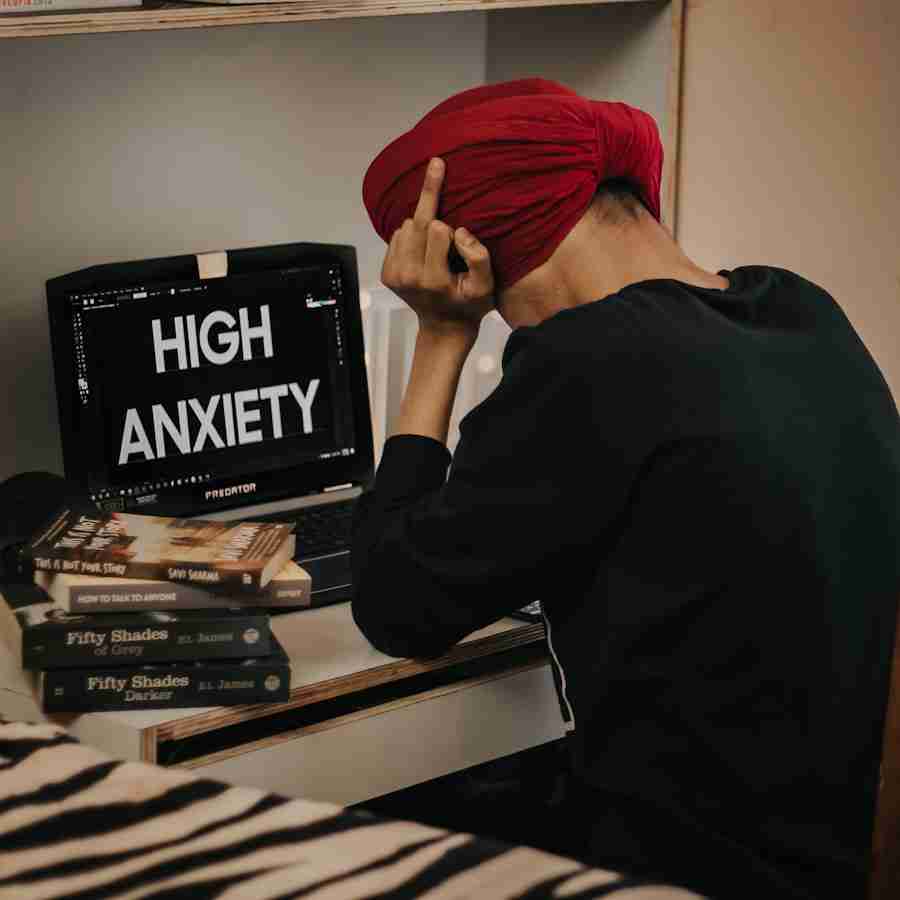Anxiety is a complex emotional response characterized by feelings of tension, worried thoughts, and physical changes such as increased blood pressure. It manifests in various forms, including generalized anxiety disorder (GAD), panic disorder, social anxiety disorder, and specific phobias. Symptoms can vary widely among individuals but often include excessive worry, restlessness, fatigue, difficulty concentrating, irritability, muscle tension, and sleep disturbances.
In some cases, anxiety can lead to physical symptoms such as rapid heartbeat, sweating, trembling, and gastrointestinal issues. These manifestations can significantly impair daily functioning and quality of life. The causes of anxiety are multifaceted and can be attributed to a combination of genetic, environmental, psychological, and developmental factors.
Research indicates that individuals with a family history of anxiety disorders are more likely to experience similar issues, suggesting a genetic predisposition. Environmental factors such as trauma, stress from work or relationships, and significant life changes can also trigger anxiety. Additionally, psychological factors like low self-esteem or a tendency to overthink situations can exacerbate feelings of anxiety.
Understanding these underlying causes is crucial for developing effective treatment strategies tailored to individual needs.
Key Takeaways
- Anxiety symptoms can include excessive worry, restlessness, and difficulty concentrating, while causes can range from genetics to environmental stressors.
- Therapy options for anxiety include cognitive behavioral therapy, exposure therapy, and acceptance and commitment therapy, each with its own approach to addressing anxiety symptoms.
- Medication options for anxiety include SSRIs, SNRIs, and benzodiazepines, which can help manage symptoms but may also have potential side effects.
- Lifestyle changes such as regular exercise, a balanced diet, and adequate sleep can play a significant role in managing anxiety symptoms.
- Relaxation techniques like meditation, deep breathing, and progressive muscle relaxation can help reduce anxiety and promote a sense of calm.
- Support groups and peer support can provide valuable emotional support and understanding for individuals dealing with anxiety.
- Alternative treatments like acupuncture, yoga, and aromatherapy may offer additional options for managing anxiety symptoms.
- Creating a personalized treatment plan for anxiety should involve a combination of therapy, medication, lifestyle changes, relaxation techniques, and support systems tailored to the individual’s needs.
Therapy Options: Cognitive Behavioral Therapy, Exposure Therapy, and Acceptance and Commitment Therapy
Reframing Negative Thoughts
For example, someone with social anxiety may believe that they will embarrass themselves in social situations. CBT helps them reframe this thought by examining evidence for and against it, ultimately leading to reduced anxiety in social settings.
Exposure Therapy: A Step-by-Step Approach
Exposure Therapy is another effective treatment modality that involves gradual exposure to feared situations or stimuli in a controlled environment. This technique is based on the principle of desensitization; by repeatedly facing their fears in a safe context, individuals can learn to manage their anxiety responses. For instance, someone with a fear of flying might start by looking at pictures of airplanes, then progress to visiting an airport, and eventually take a short flight. This step-by-step approach allows individuals to confront their fears at their own pace while developing coping strategies to manage anxiety.
Acceptance and Commitment Therapy (ACT): Embracing Psychological Flexibility
Acceptance and Commitment Therapy (ACT) offers a different perspective by encouraging individuals to accept their thoughts and feelings rather than trying to control or avoid them. ACT emphasizes mindfulness and the importance of living in accordance with one’s values. For example, someone who experiences anxiety about public speaking may learn to accept their anxious feelings while committing to practice speaking in front of others because it aligns with their personal goals. This approach fosters psychological flexibility and helps individuals engage more fully in their lives despite the presence of anxiety.
Medication Options: SSRIs, SNRIs, and Benzodiazepines

When therapy alone is insufficient to manage anxiety symptoms, medication may be considered as part of a comprehensive treatment plan. Selective Serotonin Reuptake Inhibitors (SSRIs) are commonly prescribed for anxiety disorders due to their effectiveness in increasing serotonin levels in the brain. Serotonin is a neurotransmitter that plays a crucial role in mood regulation.
Medications such as fluoxetine (Prozac) and sertraline (Zoloft) are examples of SSRIs that have been shown to alleviate symptoms of anxiety over time. While they may take several weeks to show effects, they are generally well-tolerated and have fewer side effects compared to older antidepressants. Serotonin-Norepinephrine Reuptake Inhibitors (SNRIs) are another class of medications used to treat anxiety disorders.
These drugs, including venlafaxine (Effexor) and duloxetine (Cymbalta), work by increasing both serotonin and norepinephrine levels in the brain. This dual action can be particularly beneficial for individuals who experience both anxiety and depressive symptoms. Like SSRIs, SNRIs may take time to reach their full therapeutic effect but can provide significant relief for many patients.
Benzodiazepines are a class of medications that can provide rapid relief from acute anxiety symptoms. Drugs such as lorazepam (Ativan) and diazepam (Valium) work by enhancing the effects of the neurotransmitter gamma-aminobutyric acid (GABA), which has a calming effect on the brain. While benzodiazepines can be effective for short-term management of anxiety, they carry a risk of dependence and tolerance when used long-term.
Therefore, they are typically prescribed for brief periods or in conjunction with other treatments.
Lifestyle Changes: Exercise, Diet, and Sleep
| Category | Metrics |
|---|---|
| Exercise | Number of days per week of exercise |
| Duration of exercise per session (in minutes) | |
| Intensity of exercise (e.g. moderate, vigorous) | |
| Diet | Caloric intake per day (in calories) |
| Macronutrient distribution (e.g. percentage of carbs, protein, fat) | |
| Number of servings of fruits and vegetables per day | |
| Sleep | Hours of sleep per night |
| Quality of sleep (e.g. poor, fair, good, excellent) |
Incorporating lifestyle changes can significantly impact the management of anxiety symptoms. Regular physical activity is one of the most effective ways to reduce anxiety levels. Exercise releases endorphins—natural mood lifters—and promotes relaxation by reducing muscle tension and improving sleep quality.
Activities such as running, swimming, or even brisk walking can serve as powerful tools for managing stress and anxiety. Engaging in exercise not only provides immediate relief but also fosters long-term resilience against anxiety. Diet also plays a crucial role in mental health.
A balanced diet rich in whole foods—such as fruits, vegetables, whole grains, lean proteins, and healthy fats—can positively influence mood and energy levels. Certain nutrients have been linked to improved mental health; for instance, omega-3 fatty acids found in fish have been shown to reduce symptoms of anxiety and depression. Conversely, excessive consumption of caffeine or sugar can exacerbate feelings of anxiety by causing fluctuations in energy levels and mood swings.
Sleep is another critical factor in managing anxiety. Poor sleep quality can lead to increased irritability and heightened stress responses. Establishing a consistent sleep routine that includes adequate rest is essential for mental well-being.
Techniques such as creating a calming bedtime environment, limiting screen time before bed, and practicing relaxation exercises can help improve sleep quality. By prioritizing sleep hygiene alongside exercise and diet, individuals can create a solid foundation for managing anxiety effectively.
Relaxation Techniques: Meditation, Deep Breathing, and Progressive Muscle Relaxation
Relaxation techniques are valuable tools for managing anxiety symptoms in everyday life. Meditation is one such technique that encourages mindfulness—focusing on the present moment without judgment. Mindfulness meditation has been shown to reduce stress and improve emotional regulation by promoting awareness of thoughts and feelings without becoming overwhelmed by them.
Practicing meditation regularly can help individuals develop a greater sense of calm and resilience when faced with anxious thoughts. Deep breathing exercises are another effective method for alleviating anxiety symptoms. By focusing on slow, deep breaths, individuals can activate the body’s relaxation response, which counteracts the physiological effects of stress.
Techniques such as diaphragmatic breathing involve inhaling deeply through the nose, allowing the abdomen to expand fully before exhaling slowly through the mouth. This practice not only calms the mind but also helps regulate heart rate and blood pressure. Progressive Muscle Relaxation (PMR) is a technique that involves systematically tensing and relaxing different muscle groups throughout the body.
By focusing on physical sensations associated with tension and relaxation, individuals can develop greater awareness of their body’s stress responses. PMR can be particularly beneficial for those who experience muscle tension as a symptom of anxiety. Regular practice can lead to improved relaxation skills and a greater ability to manage stress effectively.
Support Groups and Peer Support

Breaking Down Isolation
The sense of community fostered in support groups can alleviate feelings of isolation often associated with anxiety disorders. Participants often find comfort in knowing they are not alone in their struggles and can learn from one another’s journeys toward recovery. Peer support extends beyond formal support groups; it can also include friendships or connections with others who have experienced similar challenges.
Emotional Validation and Practical Advice
Engaging with peers who understand the nuances of living with anxiety can provide emotional validation and practical advice on managing symptoms. Whether through informal gatherings or online forums, peer support networks can enhance resilience by fostering connections that promote understanding and empathy.
Building a Robust Support System
Additionally, many organizations offer resources for individuals seeking support for anxiety disorders. These resources may include educational materials, helplines, or online communities where individuals can connect with others facing similar challenges. By actively seeking out support from both formal groups and informal networks, individuals can build a robust support system that enhances their coping strategies.
Alternative Treatments: Acupuncture, Yoga, and Aromatherapy
Alternative treatments have gained popularity as complementary approaches to managing anxiety disorders. Acupuncture is one such method rooted in traditional Chinese medicine that involves inserting thin needles into specific points on the body to promote balance and healing. Some studies suggest that acupuncture may help reduce symptoms of anxiety by stimulating the release of endorphins and promoting relaxation responses within the body.
Yoga combines physical postures with breath control and meditation techniques to promote overall well-being. Research has shown that regular yoga practice can lead to reductions in anxiety levels by enhancing mindfulness and fostering relaxation. The emphasis on breath awareness during yoga sessions encourages participants to focus on the present moment while releasing tension held within the body.
Aromatherapy utilizes essential oils derived from plants to promote relaxation and alleviate stress. Scents such as lavender have been shown to have calming effects on the nervous system. Incorporating aromatherapy into daily routines—whether through diffusing oils at home or using scented lotions—can create an environment conducive to relaxation and stress relief.
Creating a Personalized Treatment Plan
Developing a personalized treatment plan for managing anxiety involves considering various factors unique to each individual’s experience with anxiety disorders. A comprehensive approach typically includes a combination of therapy options tailored to address specific symptoms and underlying causes. For instance, an individual may benefit from CBT for cognitive restructuring while also engaging in exposure therapy for specific phobias.
Medication may also play a role in the treatment plan based on the severity of symptoms and individual preferences regarding pharmacological interventions. Collaborating with healthcare professionals ensures that medication choices align with therapeutic goals while monitoring potential side effects. Incorporating lifestyle changes such as exercise routines, dietary adjustments, sleep hygiene practices, relaxation techniques like meditation or deep breathing exercises, peer support networks, alternative treatments like yoga or acupuncture—all contribute to creating a holistic approach tailored specifically for each individual’s needs.
Regularly reviewing and adjusting the treatment plan based on progress is essential for achieving optimal outcomes in managing anxiety disorders effectively over time. By taking an active role in their treatment journey—whether through therapy sessions or lifestyle modifications—individuals can empower themselves toward greater resilience against anxiety.

